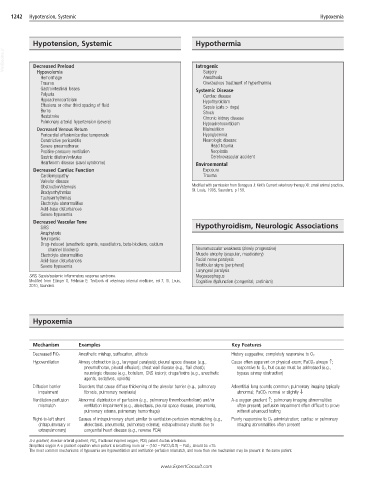Page 2493 - Cote clinical veterinary advisor dogs and cats 4th
P. 2493
1242 Hypotension, Systemic Hypoxemia
Hypotension, Systemic Hypothermia
VetBooks.ir Decreased Preload Iatrogenic
Hypovolemia
Anesthesia
Hemorrhage Surgery
Trauma Overzealous treatment of hyperthermia
Gastrointestinal losses Systemic Disease
Polyuria Cardiac disease
Hypoadrenocorticism Hypothyroidism
Effusions or other third spacing of fluid Sepsis (cats > dogs)
Burns Shock
Heatstroke Chronic kidney disease
Pulmonary arterial hypertension (severe) Hypoadrenocorticism
Decreased Venous Return Malnutrition
Pericardial effusion/cardiac tamponade Hypoglycemia
Constrictive pericarditis Neurologic disease:
Severe pneumothorax Head trauma
Positive-pressure ventilation Neoplasia
Gastric dilation/volvulus Cerebrovascular accident
Heartworm disease (caval syndrome) Environmental
Decreased Cardiac Function Exposure
Cardiomyopathy Trauma
Valvular disease
Obstruction/stenosis Modified with permission from Bonagura J: Kirk’s Current veterinary therapy XII: small animal practice,
Bradyarrhythmias St. Louis, 1995, Saunders, p 159.
Tachyarrhythmias
Electrolyte abnormalities
Acid-base disturbances
Severe hypoxemia
Decreased Vascular Tone
SIRS Hypothyroidism, Neurologic Associations
Anaphylaxis
Neurogenic
Drug-induced (anesthetic agents, vasodilators, beta-blockers, calcium
channel blockers) Neuromuscular weakness (slowly progressive)
Electrolyte abnormalities Muscle atrophy (scapular, masticatory)
Acid-base disturbances Facial nerve paralysis
Severe hypoxemia Vestibular signs (peripheral)
Laryngeal paralysis
SIRS, Sepsis/systemic inflammatory response syndrome. Megaesophagus
Modified from Ettinger S, Feldman E: Textbook of veterinary internal medicine, ed 7, St. Louis, Cognitive dysfunction (congenital; cretinism)
2010, Saunders.
Hypoxemia
Mechanism Examples Key Features
Anesthetic mishap, suffocation, altitude
Decreased FiO 2 History suggestive; completely responsive to O 2
Hypoventilation Airway obstruction (e.g., laryngeal paralysis); pleural space disease (e.g., Cause often apparent on physical exam; PaCO 2 always ↑;
pneumothorax, pleural effusion); chest wall disease (e.g., flail chest); responsive to O 2 , but cause must be addressed (e.g.,
neurologic disease (e.g., botulism, CNS lesion); drugs/toxins (e.g., anesthetic bypass airway obstruction)
agents, sedatives, opioids)
Diffusion barrier Disorders that cause diffuse thickening of the alveolar barrier (e.g., pulmonary Adventitial lung sounds common; pulmonary imaging typically
impairment fibrosis, pulmonary neoplasia) abnormal; PaCO 2 normal or slightly ↓
Ventilation-perfusion Abnormal distribution of perfusion (e.g., pulmonary thromboembolism) and/or A-a oxygen gradient ↑; pulmonary imaging abnormalities
mismatch ventilation impairment (e.g., atelectasis, pleural space disease, pneumonia, often present; perfusion impairment often difficult to prove
pulmonary edema, pulmonary hemorrhage) without advanced testing
Right-to-left shunt Causes of intrapulmonary shunt similar to ventilation-perfusion mismatching (e.g., Poorly responsive to O 2 administration; cardiac or pulmonary
(intrapulmonary or atelectasis, pneumonia, pulmonary edema); extrapulmonary shunts due to imaging abnormalities often present
extrapulmonary) congenital heart disease (e.g., reverse PDA)
A-a gradient, alveolar-arterial gradient; FiO 2 , fractional inspired oxygen; PDA, patent ductus arteriosus.
Simplified oxygen A-a gradient equation when patient is breathing room air = (150 – PaCO 2 /0.8) – PaO 2 ; should be <15.
The most common mechanisms of hypoxemia are hypoventilation and ventilation-perfusion mismatch, and more than one mechanism may be present in the same patient.
www.ExpertConsult.com

